
Manufacturer's Specifications
Drive System: Belt.
Wow & Flutter: Less than 0.1%, DIN weighted.
Rumble: Unweighted, -60 dB; weighted, -75 dB.
Speed Stability: ±0.1%.
Suspension Resonance: 2.5 Hz.
Dimensions: 20 1/4 in. W x 7 1/2 in. H x 16 1/2 in. D (51.4 cm x 19 cm x 41.9 cm).
Price: $1,600 (oak finish), $1,800 (black lacquer); Electronic Flywheel power-line conditioner, $300.
Company Address: P.O. Box 7075, Berkeley, Cal. 94707.
SOTA, which stands for State Of The Art, is also the name of a small, dedicated company, located in Oakland, California, which manufactures a very high-quality turntable that they claim is "the turntable that Newton would have built." In addition, they make some interesting electronic and accessory products meant to increase the performance of record-playing equipment.
The Star Sapphire is the latest version of a basic turntable which SOTA began manufacturing a few years ago, all designed according to the theory that the supporting mass must exceed the moving platter mass. The major current improvement is the addition of a vacuum record-clamping system; it is also available as a retrofit for the original SOTA Sapphire for about $600, plus dealer installation. (You might want to look up the report on the SOTA Sapphire turntable in the June 1983 issue of Audio, because the new Star Sapphire is very similar but has some important improvements.) The Star Sapphire that I tested was also isolated from the a.c. power line by a new unit which SOTA calls the Electronic Flywheel and describes as a power-line conditioner. This acts as a power reservoir which regulates the voltage and removes noise from the a.c. power line. The Electronic Flywheel is also available separately, for $300, and may be used not only with the Sapphires, but also with some other d.c. servo turntables. The vacuum clamping system and the Electronic Flywheel are each capable of improving the performance of the turntable, and taken together, they represent a real advance.
This particular Star Sapphire was finished in satin black, even including the wood base. The hinged dust cover is vacuum molded from a soft smoked-brown acrylic plastic. I was able to set the hinges so that the lid would lock in place in a partly opened position. This is handy when the shelf above the turntable doesn't allow the lid to be opened fully.
One thing that you may find strange is that there are no markings on any of the controls! Of course, after you have figured out which knob does what, by reading the instructions, you really won't need the markings anymore. (Be sides, think of the power you will have by being the only person who knows where the on/off switch is!) The cover of the control area is different than that of the original Sapphire turntable. It is made of wood, has beveled edges and a satin black finish, and is held in place by Velcro fasteners.
(The original Sapphire has a metal control cover, which is held by screws.) The new cover can be popped on and off easily. although there is really no reason or need to do this; still, I like it and think that it is a clever touch.
I usually have no trouble locating a spot for any turntable I am testing, but this time I also had to find a spot for the vacuum system and the Electronic Flywheel chassis. I put these control units on a separate shelf for some of the tests and on the floor for some others. The noise level of the vacuum system is not very high, but in extremely quiet situations, it would be best to keep it away from your listening position. The vacuum hose is 91/2 feet long, so there is some flexibility in where you can locate the vacuum control chassis.
Measured Data
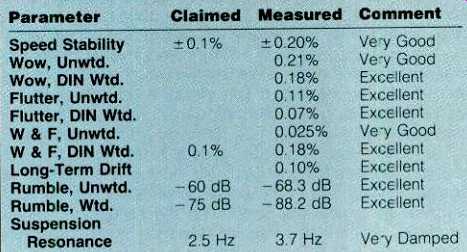

Fig. 1--Computer plot of wow and flutter spectrum, from 0 to 100 Hz. The peak
at 6.5 Hz is due to the tonearm/cartridge resonance.
High mass means high inertia and immunity from outside forces, and it is one of the main features of the SOTA turntable design. SOTA engineers believe that the best way to suspend a mass that is spread over a surface, is by not allowing any part of that surface to be outside the area bounded by the suspension. This means that no part of the surface can rotate around an axis formed by two adjacent supports. It follows, then, that the best way to suspend a rectangular surface is by placing four springs at the corners. (This is different from supporting a rigidly suspended mass, such as a turntable base with noncompliant feet, because a four-point rigid support system could allow the mass to rock around an axis formed by opposite corners.) Extra mass, of about 2 1/2 pounds, is added at each of the suspension points. The resonance of the turntable suspension is controlled by using calibrated springs, and by adjusting the amount of this added mass. Since the linear on-axis motion of a coiled spring is accompanied by rotary motion, the Star Sapphire's springs are counter-wound pairs positioned at opposite corners of the suspended mass.
Each spring supports 8 pounds, so the total suspended weight is 32 pounds. A very important difference between the two SOTA Sapphire models and other turntables is that the mass is slung below the springs rather than being perched on top of them. The force of gravity thereby causes the springs to find a stable equilibrium. If the turntable is perched on top of springs, as is often the case with other designs, the force of gravity draws the suspended mass toward an unstable condition.
The mass of the tonearm must be accounted for in balancing the total suspended mass. Since tonearms of various mass must be accounted for, SOTA supplies lead shot in a plastic bag and a spirit level. With the tonearm mounted on the board, the turntable is balanced by pouring the lead shot into a styrene cup, placed on the tonearm board, while watching the bubble in the spirit level. When the mounting board is level, it can be lifted up, and the lead shot poured into the well under the board. The original SOTA turntables had a hole and plug in the tonearm mounting board into which the lead shot was poured; this proved to be a disadvantage when the turntable had to be transported, because the lead shot could spill out.
The turntable platter is a low-pressure casting, tapered so most of its mass is at its periphery. It is lead lined for high mass and high internal damping, and machined on a CNC (computer numerical controlled) lathe to 0.0002-inch accuracy. Each turntable shaft is matched to a precision, sintered-bronze bearing sleeve and mounted in a surface support block. The shaft and bearing are mounted into a test fixture, and the perpendicularity is checked. If it is within the tolerance allowed, the sapphire thrust bearing is put into position and the combination is rechecked.
The SOTA Star Sapphire turntable has two speeds, 33.3 and 45 rpm, which are selected by a pushbutton. Separate knobs are used to control the exact pitch of each speed.
There is no built-in speed indicator, so a strobe disc is supplied. It can be used with ordinary fluorescent lighting to set the exact speeds of 33.3 and 45 rpm by adjusting the appropriate pitch knob until the lines on the strobe disc appear stationary.
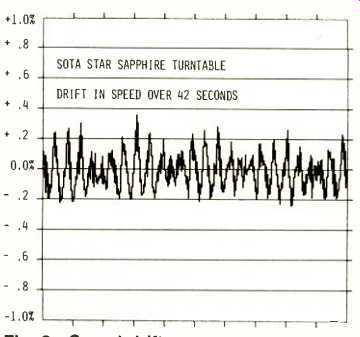
Fig. 2--Speed drift over a 42-S period. The variations are at 1.8 S per cycle
(0.56 Hz), related to the 33.3-rpm speed.
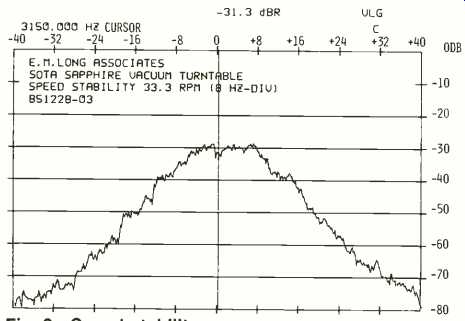
Fig. 3--Speed stability, referenced to 3,150-Hz tone on band 8 of B & K
2010 test record.
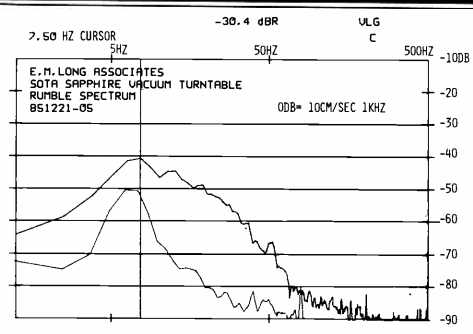
Fig. 4--Rumble spectrum, measured with B & K 2010 test record (upper curve)
and with Thorens Rumpelmesskoppler (lower curve). The main factor in the rumble
is the tonearm/cartridge resonance.
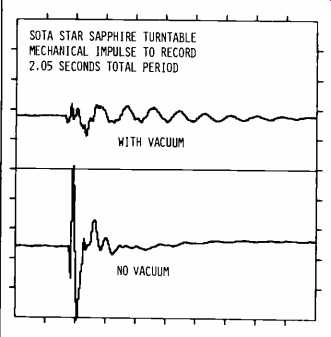
Fig. 5--Output vs. time for mechanical shock applied to edge of record, with
stylus resting in groove. Results show effect of vacuum applied (upper trace)
and not applied (lower trace). Measurement period is 2.05 S.
The vacuum record hold-down system is the Star Sapphire's single most important improvement over the previous Sapphire turntable. The vacuum pump and the associated control electronics and power supply are mounted in a chassis which is completely separate from the turntable.
The vacuum, which is created between the underside of the record and the top of the turntable platter, causes the record to be pressed against the turntable platter surface by the force exerted by the surrounding air pressure. The record isn't actually pressed directly against the platter, because there is an interface, which consists of an acrylic plastic disc and a mat of highly damped rubber. The acrylic disc's internal characteristics are similar to those of a vinyl phonograph record. This allows most of the record's internal kinetic energy to be transferred from the vinyl record to the acrylic plastic disc with very little difficulty, because their impedances are similar. This energy is then dissipated in the highly damped rubber barrier, which is between the acrylic disc and the aluminum turntable platter. The rubber mat also damps out the energy caused by the natural resonance of the turntable platter. Two main attributes of the vacuum system enhance the Star Sapphire's performance:
First, since the force pressing the record against the acrylic disc is applied in a very uniform and evenly distributed manner, the mechanical standing-wave energy inside the record can be dissipated in a similarly uniform manner. It also means that more internal energy, which would other wise color the sound, can be removed from the record.
The other attribute is due directly to the flatness of the record, caused by the vacuum pulling the record flat against the surface of the acrylic disc; a flat record is not warped! (In a previous report, on the Nakamichi Dragon turntable, which had a record-centering system that pre vented wow due to eccentricity, I commented that all we needed now was a turntable that would move up and down to remove the effects of warp! I was being facetious, of course, because the obvious solution is to make flat records (there I go again!) or to pull the records flat against the turntable platter by using a vacuum system.) The Star Sapphire's vacuum system reduces the effects of warp wow by removing the vertical component due to warped records. If you are willing to spend a little time centering a record on the Star Sapphire before you sit down to listen, you will be amazed at the difference in the clarity of the sound.
Measurements and Listening Tests
The SME V tonearm and the Talisman Virtuoso moving coil cartridge were used for the technical measurements and listening tests. The low-frequency spectrum of the wow and flutter pre sent while reproducing the 3,150-Hz tone on the B & K 2010 test record is shown in Fig. 1. It represents 16 samples of the filtered output of a wow and flutter analyzer (which I also used for drift tests). The increased output at 6.5 Hz is due to the resonance caused by the interaction of the tonearm's effective mass and the compliance of the cartridge stylus suspension. The test record was not perfectly centered during this test because I wanted to show the large effect that the tonearm/cartridge resonance can have on the total energy output of the wow and flutter spectrum. If the wow and flutter were determined by merely observing the fluctuating pointer of a wow and flutter meter, the resulting figure would be higher for a poorly damped tonearm/cartridge combination reproducing a warped and off-center record than for a well-damped tonearm/cartridge combination re producing a flat, well-centered record. In other words, a turntable could be blamed for having a much worse wow and flutter when it actually could be due, mainly, to the poorly damped low-frequency tonearm/cartridge resonance. The listening panel's comments on the reproduction of piano recordings by the Star Sapphire were very favor able with regard to the stability of sustained tones. I was able to hear an effect, however, while reproducing test tones, which I could associate with the data shown in Fig. 2.
This is a cyclical variation which repeats every six rotations of the record. The zero line represents exactly 3,150 Hz, and the graduated lines, plus and minus, represent the percentage of speed increase or decrease from 3,150 Hz. However, like the members of the listening panel, I couldn't hear this effect when the Star Sapphire turntable was reproducing musical recordings. No listening-panel member made any comment which I could definitely correlate with this cyclical phenomenon.
Figure 3 is the spectrum of the frequency variation caused by the wow and flutter and indicates that the variation in speed varies in a rather uniform manner around the 3,150-Hz tone. The data represents the summation of 24 spectrum samples.
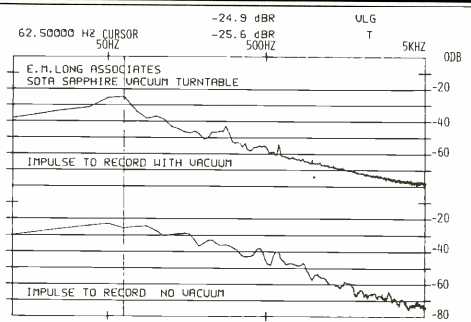
Fig. 6--Spectrum (to 5 kHz) of impulse shown in Fig. 5, with vacuum applied
(upper curve) and without (lower curve). The tight contact between the record
and the platter's interface disc when vacuum is applied reduces spurious energy.
Except at the cursor position (62.5 Hz), energy is reduced by 10 dB or more, the best measured by the reviewer for any record-clamping system.
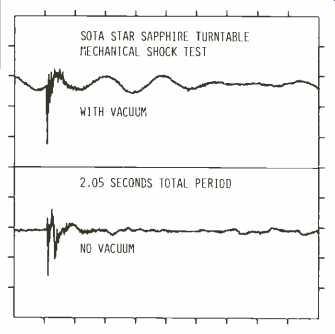
Fig. 7--Output vs. time for mechanical shock to platform upon which the turntable
base rested, with vacuum applied (upper curve) and without vacuum (lower curve).
Measurement period is 2.05 S.
The rumble spectrum data which appears in Fig. 4 is a little different from what I've shown in past reports. Usually I have shown only the spectrum of the rumble caused by reproducing the B & K 2010 test record; this is represented here by the upper curve in Fig. 4. The lower curve was made using the Thorens Rumpelmesskoppler (German for rumble-measurement coupler), a special device which al lows turntable rumble to be measured indirectly, thereby avoiding the artifacts inherent in the test record. Although I am not convinced that using this device is the best way to measure turntable rumble, I did so here because I wanted to show the effect of the tonearm/cartridge resonance on the rumble spectrum. As you can see, both the spectrum produced by the test record and the spectrum produced by the Rumpelmesskoppler show that tonearm/cartridge resonance is the major factor in the total rumble output. This is true of almost every modern, high-quality turntable and is certainly true of the turntables I have tested in the recent past. Once again, as in the case of wow and flutter, you can see the large effect that the tonearm/cartridge resonance has upon the measured performance. A poorly damped tonearm/cartridge resonance will cause a turntable to pro duce worse rumble figures than it justly deserves. In any case, the SOTA Star Sapphire turntable has extremely low rumble, and none of the members of the listening panel made any negative comments in this regard.
The ability of the vacuum record-clamping system to damp the energy in a phonograph record is shown in Figs. 5 and 6. For this test, a mechanical impulse is applied to the edge of a stationary phonograph record while the stylus of the phono cartridge is resting in a groove. The dramatic difference in the output versus time is shown in Fig. 5: The top curve indicates how the energy in the record, due to the first instance of the mechanical shock, is extremely well damped by the vacuum clamping. The lower curve shows the output versus time when the vacuum system is not activated; the initial energy impulse is many times greater than that shown for the vacuum system. Most of the comments of the listening panel about the difference in the quality of reproduction between the SOTA Star Sapphire and the reference system could be correlated to the vacuum system's effect upon the sound. In fact, during one comparison test, the vacuum between the Star Sapphire turntable platter and the phonograph record was released, allowing the tight coupling to be relaxed. This caused listening-panel members to become confused as to which turntable was "A" and which was "B" because these turntables seemed to have reversed their characteristics completely! The effect of the vacuum system on the quality of sound reproduction was clearly evident in comments made by the listening-panel members. Comments about violin and brass indicated that the reference system was "brighter," "sharper," "more forward." The vacuum clamping system made the sound quality a' cymbals "duller"--an apparent paradox, which I will explain shortly.
The two spectra of Fig. 6 show how the vacuum clamping system is very effective in reducing the mid- and high-frequency energy from the record caused by a mechanical impulse to the record's edge. Except at low frequencies, such as 62.5 Hz where I set the cursor, the level is some where between 10 and 15 dB lower for the vacuum clamping system. When this much energy is removed from the record in the middle and upper frequencies, the quality of the sound is bound to be affected. Because the sound was different from what we were used to hearing, it seemed to be wrong at first. However, upon extended listening, it became apparent that the sound from the SOTA with its vacuum was more real than that from the reference system, and in a very convincing way. The reference system has a good record-clamping system which gives good standing wave energy removal, but it is no match for the SOTA Star Sapphire's vacuum clamping system.
Figure 7 shows output versus time for a mechanical shock applied to the platform upon which the turntable and base rested. The upper curve is with the vacuum system operating, and the bottom curve is with the vacuum turned off. The difference is due to the fact that when the vacuum is re leased, the record tends to be held away from the turntable platter by the rubber sealing ring which circles the edge of the acrylic damping disc. The spectrum data shown in Fig. 8 is for the same conditions as the time data in Fig. 7. Both with and without vacuum, the energy below 500 Hz is very low in level (shown in Fig. 8) and is quickly dissipated (Fig. 7). The interesting information brought out by these measurements is that the rubber sealing ring must be seated very carefully around the periphery of the record. This will prevent the ring from causing audibly bad effects in the reproduced sound.
Figure 9 is interesting because it shows almost nothing! It is the spectrum of the energy picked up by the stylus, resting in a stationary groove near the middle of a record, while a slow 20 to 100-Hz sweep from an oscillator produced an acoustic level of 100 dB SPL at the surface of the record. The data shown was measured with the turntable's lid open. I also ran the test with the lid closed, to check for any possible cavity resonance effects; the data was essentially identical to that shown. The isolation of the SOTA Star Sapphire from nearby high-level sound is remarkable and indicates that its suspension system and high mass are very effective.
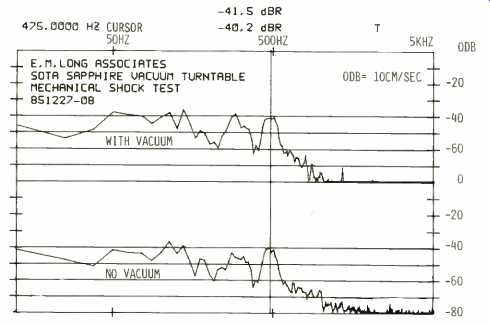
Fig. 8--Spectrum (to 5 kHz) of impulse shown in Fig. 7, with vacuum applied
(upper curve) and without (lower curve). Isolation from external vibrations
is excellent.
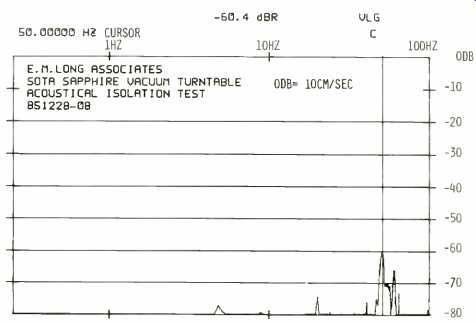
Fig. 9--Spectrum (to 100 Hz) of vibrations from a 100 dB SPL acoustic field
at the surface of the record. Stylus was resting in a groove near the middle
of the record. Isolation from the acoustic field is extraordinary.
Conclusions
I found that sorting through the listening panel's comments and checking the final scores that were given to the SOTA Star Sapphire and the reference turntables while they reproduced various types of program material were more interesting than usual. This seemed to be due mainly to the difference in sound quality produced by the vacuum clamping system. At first, there were contradictions in some of the comments and in the choice of which system was more satisfactory, but this changed as the tests progressed.
The Electronic Flywheel power-line conditioner was used with the SOTA Star Sapphire, but since the a.c. power line in my lab is generally very stable and free of radio frequency interference, I cannot find any specific correlation with its use. I have no doubt, however, that if you have problems with the purity of the a.c. line, the Electronic Flywheel would be a very good solution.
If you like a bright, forward quality to reproduced sound, you may not take to the SOTA Star Sapphire right away. I am convinced, however, that if you are seeking the most realistic reproduction of sound from analog records, you will like the extra clarity afforded by the vacuum clamping system. Also, the retrofitting of the new vacuum clamping system to already excellent, older SOTA Sapphire turntables is certainly very worth the cost.
--Edward M. Long
( Audio magazine, Jun. 1986)
Also see:
SOTA Sapphire Turntable (Jun. 1983)
SOTA Cosmos Turntable / SME 309 Arm & Signet OC9 Cartridge (Equip. Profile, Sept. 1990)
SME V Tonearm and Talisman Virtuoso DTi Cartridge (Jun. 1986)
= = = =